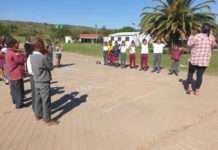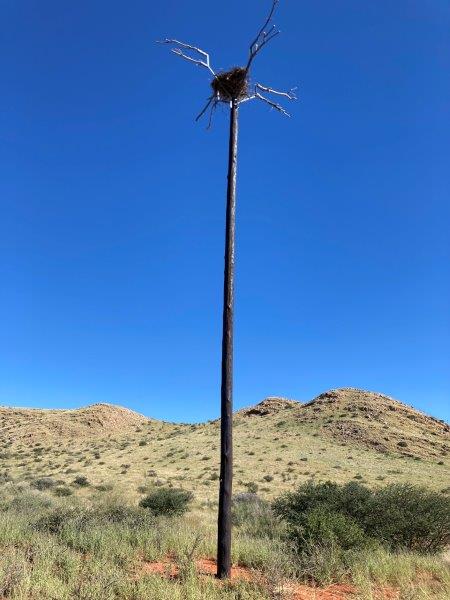South Africa is facing an energy crisis. The rush for getting renewable energy projects off the ground is ever-increasing and brings with it the need for new transmission infrastructure and upgrading existing infrastructure. It is at the ecotone between development and the natural environment where human-wildlife interaction prominently comes to the fore. This is also the case for transmission line upgrades, where many bird species have found the pylon structures suitable for nesting platforms. In many cases, some of South Africa’s most iconic birds of prey construct their nests on pylons. The birds have an electrocution risk and a high risk of collision with conductor cables. The challenge is finding ways to conserve our avifaunal resources whilst at the same time advancing development.
Umoyilanga (Pty) Ltd. is a preferred bidder in the Department of Mineral Resources and Energy’s (DMRE) Risk Mitigation Independent Power Producer Procurement Programme (RMIPPPP). The hybrid project, which EDF Renewables is developing, comprises the Dassiesridge wind energy and battery storage facility in the Eastern Cape and the Avondale Solar PV and battery storage facility in the Northern Cape. Both facilities form the Umoyilanga project, delivering 75 MW of baseload capacity to Eskom.
EDF Renewables aims to develop the Avondale Hybrid Solar Project located approximately 30 km East of Upington in the Northern Cape. To connect Avondale to the national electrical grid, Eskom requires EDF Renewables to decommission and rebuild a 30 km section of the existing Gordonia-Garona 132 kV transmission line between the Avondale site and the Gordonia substation located east of Upington on the outskirts of the town.
A basic assessment (BA) environmental process was undertaken to obtain Environmental Authorisation to upgrade the transmission line. Zutari was appointed as Environmental Assessment Practitioner.
Zutari commissioned an ornithologist (bird specialist) to undertake an avifaunal impact assessment study to understand the risks and potential impacts that could be experienced by avifauna if the project were to be implemented. During the fieldwork undertaken as part of the study, Dr. Owen Davies from Arcus Consultancy Services South Africa (Pty) Ltd., an ERM Group company, identified two eagle nests on the existing lattice pylons, one belonging to a Martial Eagle and the other to a Verreaux’s (Black) Eagle. Due to the absence of suitable natural nesting locations, Martial Eagles frequently nest on lattice pylons. In contrast, Verreaux’s Eagles usually prefer to nest on inaccessible cliff faces, which are neither present on nor near the project site, which is likely why the pylons were used.
This posed a challenge to the project team as the existing lattice pylons had to be upgraded and replaced. A plan had to be made to find an alternative nesting platform for the birds, and the eagle nests had to be moved before the commencement of construction.
In November 2021, the National Department of Forestry, Fisheries and the Environment (DFFE) granted Environmental Authorisation for the project to upgrade the transmission line, subject to the relocation of the two eagle nests.
To complete the design and placement of the alternative nesting platforms, EDF Renewables collaborated with the Endangered Wildlife Trust (EWT) Birds of Prey Programme. Dr. Gareth Tate from EWT provided recommendations for the alternative nesting structure design based on the typical nesting structures built by the two species. In collaboration with Dr. Davies, and after a site visit by the EWT, suitable locations for the nesting structures were selected based on distance from the original nest location, position relative to the prevailing wind direction and surrounding rocky outcrops, as well as habitat suitability models provided by BirdLife South Africa.
Based on the design developed by the Zutari engineering team, two 15-m-high nesting structures were built. The structures comprise a creosote pole and a steel ‘basket’ with perching space at the top. In April 2022, Eskom took down the two existing nests from the pylons with guidance from EWT and relocated them to the new position. A rudimentary nest was rebuilt on the structure to lure the birds into continuing further nest construction.
In July 2022, the Verreaux Eagle was spotted using the new nesting structure and in August 2022 a chick was seen inside the nest. To the team’s knowledge, this is the first ‘known’ successful Verreaux’s Eagle nest relocation in South Africa and monitoring the nest and the chick will be ongoing. The Martial Eagle is not expected to breed this season and monitoring its new nest location will continue.
The successful relocation of the nests is a very encouraging step towards conserving these top predators as they frequently nest on lattice pylon structures which will require replacement and upgrading throughout South Africa as older infrastructure needs to be replaced. In addition, the upgraded transmission line has been designed according to Eskom’s bird-friendly standards, with bird flight diverters to be installed along sections identified by the bird specialist.
Verreaux’s Eagles are listed as locally vulnerable, while Martial Eagles are a globally endangered species, with an estimated 800 mature birds left in Southern Africa. All breeding pairs must be protected, and nesting sites must be undisturbed. There has been very little evidence around the potential impact or success of nest relocations. Therefore, this project’s success proves that nest relocations can be successful when appropriately conducted. This will provide an essential baseline for future nest structure designs, placement and relocations for all large eagles that breed on electrical infrastructure. We recommend that raptor specialists are always contacted before moving eagle nests, and that nests should only be relocated in extreme cases such as this.












